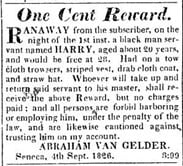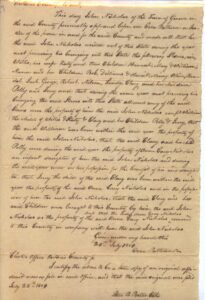Slavery in New York State
By Kerry Lippincott, Executive Director
Rose Hill is filled with stories. One that shocks and surprises visitors is slavery. Slavery was legal in New York from 1626 through the 1840s. From 1792 to 1796 and 1803 to 1827 enslaved workers lived and worked on the Rose Hill property.
Slavery existed in all thirteen original colonies. Slavery began in colonial New York in 1626 when the Dutch West Indies Company brought eleven enslaved Africans to their colony of New Amsterdam (present day New York City). The colony’s primary purpose was to make a profit from selling beaver furs and other goods in Europe. Though the colony’s development was encouraged, the Company distributed profits as dividends to shareholders rather then re-invest them into the colony. It was also hard to attract permanent settlers from Holland. Many came temporarily to New Amsterdam to earn money from the fur trade and return to Holland. Others saw no reason to immigrate. Without political and religious pressures and relatively good economic conditions in Holland, many had little reason to leave.[1]
Though a young colony, labor shortages were a continual problem in New Amsterdam. A solution was found with enslaved Africans. Their primary tasks were to clear land, plant, and harvest crops, and build houses, roads, bridges, forts and public buildings. [2] Due to settlement patterns slavery in colonial New York was primarily concentrated in New York City, on Long Island and the Hudson Valley. The development of the Hudson Valley, in fact, was primarily due to slavery. With land brought under cultivation and labor that made farming profitable, settlers began settling permanently in the area.[3] Overall slavery stabilized the colony’s economy and transformed New Amsterdam from “a shaky commercial outpost into a permanent settlement.”[4] By 1650 about 25% of the colony’s population were enslaved workers.[5]
In 1664 the British took control of New Amsterdam. The last Dutch act and first British act was to acknowledge that the rights to own enslaved people established under Dutch rule would be respected.[6]. As domestic workers, craftsmen, agricultural laborers, and unskilled workers, enslaved workers continued to fulfill a need for labor. Additionally, under British rule slavery increasingly became based on race. Under the law indentured servants became defined as individuals who willingly sold themselves for a set period of time. Indentured labor became harder to obtain and expensive.[7] Native American slavery was prohibited in the colony in 1679. Status of the mother also determined whether a child was enslaved or free. By the end of the seventeenth century an enslaved person in colonial New York meant a person of African descent.[8]

An advertisement published in the Geneva Gazette on September 6, 1826 offered one cent for the return of an enslaved man named Henry to Abraham Van Gelder.
Throughout the colonial period enslaved workers gained their freedom in numerous ways. The Dutch offered half freedoms, or a conditional freedom, to enslaved people. In return for their freedom, they had to pay an annual tribute to the Dutch West Indies Company and promise to perform labor for their former enslavers at a certain time. Half freedom status could not, however, be passed onto children.[9] Whether during their own lifetime or upon their death, some enslavers freed their enslaved workers. Enslaved people sought to free themselves by seeking refuge with Native Americans; purchasing freedom for themselves and family members; fleeing to another colony or Canada; or passing for white. The American Revolution also provided opportunities for enslaved people to seek freedom. Beginning in 1779 the British followed a policy of granting freedom to any enslaved person who sought asylum with their Army. African Americans with the British prior to the signing of the provisional peace treaty on November 30, 1782, were declared free. Over 3,000 officially left with the British while hundreds more left unrecorded.[10] Within a year of the war’s start the Continental Army offered freedom in exchange for military service. New York State also granted freedom to enslaved soldiers after three years of military service. Enslavers, however, were to be compensated by state with 500 acres of public land for each enslaved worker allowed to enlist.[11]
Between 1781-1817 the New York State Legislature passed a series of laws for the gradual emancipation of enslaved people. In 1781 the New York Legislature passed a law freeing all enslaved people serving in the state’s armed forces regardless of their length of service. [12] Four years later the Assembly passed legislation freeing all enslaved children born after 1785. The children, however, were to be indentured to their former enslavers until women were 22 and men 25. Attached to the legislation were restrictions on the rights of African Americans. They were denied the right to vote and hold public office, racial intermarriages were forbidden, and African Americans were forbidden from giving testimony against whites in court. Though the Senate agreed to gradual emancipation, an agreement could not be reached on what rights to extend to African Americans and no further action on the legislation was made.[13]
In 1799 both houses of the Legislature passed a law that freed children born to enslaved mothers after July 4, 1799. Like the 1785 proposed legislation, the children were to be indentured to their former enslavers until women were 25 and men 28. The age limit on the indentures were revised several times until the period of indenture was shortened to 21 years for both men and women.[14] Additional legislation was passed in 1817 that would free enslaved people born before July 4, 1799, as of July 4, 1827. Children born to enslaved women before July 4, 1827, would still be indentured until they were 21. Under the law, the earliest they would be free was 1848.[15]

Even though the New York State legislature implemented gradual emancipation, the importation of enslaved people was allowed if their enslaver came to live permanently in the state. Through affidavits enslavers like John Nicolas proved their enslaved people were born outside of the state before July 4, 1799.
Along with gradual emancipation the institution of slavery was attacked through legislation. Enslavers were no longer required to post a bond upon freeing enslaved workers to ensure they would not become a public charge. Enslaved workers owned by the state were freed. Restrictions were placed on the importation and exportation of enslaved people into and out of the state. However, the importation of enslaved people into the state was allowed if the enslaver came to live permanently in New York. Slave marriages were validated, children of enslaved parents were legitimized, and the separation of spouses were prohibited. Enslavers were were required to teach their enslaved workers how to read. Enslaved people were also granted the right to a trial by jury and own and transfer property through a will.[16]
A variety of reasons brought the end of slavery to New York State. Influenced by the ideals of the American Revolution the surrounding states of Vermont, Pennsylvania, Massachusetts, Connecticut, and Rhode Island freed enslaved workers outright or implemented gradual emancipation between 1777 and 1784. Enslaved people continued to find ways to free themselves and their families. Among religious groups like Quakers there were changing perceptions about slavery. Courts increasingly gave anti-slavery interpretation to the laws. Finally, there were economic and social changes in the state itself. With a high birth rate and increase in immigration, more free labor was available which also drove down wages. Unlike in the South, the availability of free labor and lower wages meant slavery was no longer economical in New York. [17]
According to the first United States Census in 1790, there were 21,129 enslaved people in New York State. By the 1830 Census there were 75 enslaved people, and none were recorded in the 1840 Census.[18] Even though they were free, African Americans would continue to struggle for equal treatment in church, education, the workplace, housing, and under the law
The next article will explore slavery at Rose Hill.
Endnotes
[1] Edger McManus. A History of Negro Slavery in New York (Syracuse, NY: Syracuse University, Press, 1966), 2-4.
[2] Alan J. Singer. New York and Slavery: Time to Teach the Truth (Albany, NY: State University of New York Press, 2008), 243 and McManus 4.
[3] McManus, 4.
[4] Ibid., 4
[5] Ira Berlin and Leslie M. Hanes, editors. Slavery in New York (New York, NY: The New Press, 2005), 35
[6] Berlin, 10.
[7] McManus, 24.
[8] Ibid., 24, 60, and 79-80.
[9] Ibid., 13-24.
[10] Ibid., 117, 154, 158-9,
[11] Ibid., 157,
[12] Ibid., 158,
[13] Berlin 122-3 and McManus 162-5,
[14] Berlin 125 and 132-33 and McManus 174-6,
[15] Berlin 133
[16] Berlin 124-5 and 131 and McManus 166-7, 177-8,
[17] McManus 118, 168-73,and 177.
[18] Berlin, 144.

